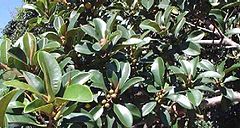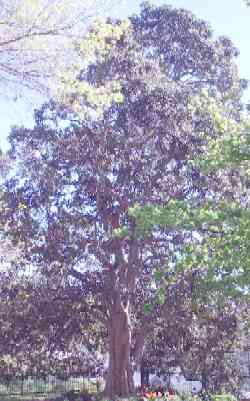Ficus rubiginosa: Difference between revisions
No edit summary |
No edit summary |
||
| Line 1: | Line 1: | ||
{{SPlantbox | |||
|familia=Moraceae | |||
|genus=Ficus | |||
|species=rubiginosa | |||
|habit=tree | |||
|habit_ref=Flora - A Gardener's Encyclopedia ISBN 0881925381 | |||
|Max ht box=60 | |||
|Max ht metric=ft | |||
|height_ref=Flora - A Gardener's Encyclopedia ISBN 0881925381 | |||
|Max wd box=35 | |||
|Max wd metric=ft | |||
|width_ref=Flora - A Gardener's Encyclopedia ISBN 0881925381 | |||
|lifespan=perennial | |||
|life_ref=Flora - A Gardener's Encyclopedia ISBN 0881925381 | |||
|exposure=sun | |||
|sun_ref=Flora - A Gardener's Encyclopedia ISBN 0881925381 | |||
|Temp Metric=°F | |||
|min_zone=9 | |||
|usda_ref=Flora - A Gardener's Encyclopedia ISBN 0881925381 | |||
|max_zone=11 | |||
|image=Upload.png | |||
|image_width=240 | |||
}} | |||
{{Taxobox | {{Taxobox | ||
| color = lightgreen | | color = lightgreen | ||
Revision as of 03:35, 20 July 2010
| Ficus rubiginosa subsp. var. | ||||||||||||||||||||||||||||||||||||||||||||||||||||||||
|---|---|---|---|---|---|---|---|---|---|---|---|---|---|---|---|---|---|---|---|---|---|---|---|---|---|---|---|---|---|---|---|---|---|---|---|---|---|---|---|---|---|---|---|---|---|---|---|---|---|---|---|---|---|---|---|---|

|
|
| ||||||||||||||||||||||||||||||||||||||||||||||||||||||
| ||||||||||||||||||||||||||||||||||||||||||||||||||||||||
| Port Jackson Fig {{{status}}} Fossil range: {{{fossil_range}}}
| ||||||||||||||||||||||||||||||||||||||||||||||||||||||||||||||||||
|---|---|---|---|---|---|---|---|---|---|---|---|---|---|---|---|---|---|---|---|---|---|---|---|---|---|---|---|---|---|---|---|---|---|---|---|---|---|---|---|---|---|---|---|---|---|---|---|---|---|---|---|---|---|---|---|---|---|---|---|---|---|---|---|---|---|---|
 Port Jackson Fig leaves and fruit | ||||||||||||||||||||||||||||||||||||||||||||||||||||||||||||||||||
| Plant Info | ||||||||||||||||||||||||||||||||||||||||||||||||||||||||||||||||||
| ||||||||||||||||||||||||||||||||||||||||||||||||||||||||||||||||||
| Scientific classification | ||||||||||||||||||||||||||||||||||||||||||||||||||||||||||||||||||
| ||||||||||||||||||||||||||||||||||||||||||||||||||||||||||||||||||
| [[{{{diversity_link}}}|Diversity]] | ||||||||||||||||||||||||||||||||||||||||||||||||||||||||||||||||||
| {{{diversity}}} | ||||||||||||||||||||||||||||||||||||||||||||||||||||||||||||||||||
| Binomial name | ||||||||||||||||||||||||||||||||||||||||||||||||||||||||||||||||||
| Ficus rubiginosa Desf. ex Vent. | ||||||||||||||||||||||||||||||||||||||||||||||||||||||||||||||||||
| Trinomial name | ||||||||||||||||||||||||||||||||||||||||||||||||||||||||||||||||||
| {{{trinomial}}} | ||||||||||||||||||||||||||||||||||||||||||||||||||||||||||||||||||
| Type Species | ||||||||||||||||||||||||||||||||||||||||||||||||||||||||||||||||||
| {{{type_species}}} | ||||||||||||||||||||||||||||||||||||||||||||||||||||||||||||||||||
| {{{subdivision_ranks}}} | ||||||||||||||||||||||||||||||||||||||||||||||||||||||||||||||||||
| [[Image:{{{range_map}}}|{{{range_map_width}}}|]] | ||||||||||||||||||||||||||||||||||||||||||||||||||||||||||||||||||
| Synonyms | ||||||||||||||||||||||||||||||||||||||||||||||||||||||||||||||||||
| {{{synonyms}}} |
The Port Jackson Fig (Ficus rubiginosa) , also known as the Little-leaf Fig or the Rusty Fig, is a native of eastern Australia and a banyan of the genus Ficus which contains over 600 species worldwide in warm climates, including the edible fig (Ficus carica).
Well known in parks and public gardens in east coast towns and cities, it is also a valuable plant for wildlife and habitat. Like all figs it requires pollination by a particular wasp species to set seed. This actually occurs fairly readily as fig seedlings are a common site in walls, cracks, crevices and buildings in urban areas of cities such as Sydney.
It was known as damun (pron. "tam-mun") to the local Eora and Darug inhabitants of the Sydney basin.[1]
Description

It is slow growing, reaching 7-15 metres in height when mature, forming a spreading densely shading tree. Its appearance is that of a small version of its relative the Moreton Bay Fig, the Port Jackson being generally smaller, with smaller fruit and leaves. Having similar ranges in the wild they are often confused, the rusty colour of the undersides of the leaves of the Port Jackson Fig being the easiest distinguishing feature.
In tropical and humid climates, the lower branches of the Port Jackson Fig may form aerial roots which strike root upon reaching to the ground, forming secondary root systems. This process is known as banyaning after the banyan tree of which it is a characteristic.
Ecology
It is pollinated by a symbiotic relationship with a wasp species (Pleistodontes imperialis) The fertilised female wasp enters the receptive 'fig' (the syconium) through a tiny hole at the crown (the ostiole). She crawls around the inflorescenced interior of the fig, pollinating some of the female flowers. She then lays her eggs inside some of the flowers and dies. After several weeks development in their galls, the male wasps emerge before the females. They chew holes in the galls containing females and fertilise them through the hole they have just chewed. Males return later to mated females, and enlarge the mating holes to enable the females to emerge. Some males then chew their way through the syconium wall, which allows the females to disperse after collecting pollen from the now fully developed male flowers. Females then have a short time (< 48 hours) to find a tree with receptive syconia to successfully reproduce and disperse pollen.
Cultivation
It is commonly used as a large ornamental tree in eastern Australia, in parts of New Zealand, and also in Hawaii and California in the USA, where it is also listed as an invasive species in some areas. Despite the size of the leaves, it is popular for bonsai work as it is extremely forgiving to work with and hard to kill.
It is very easily propagated by cuttings.
See also
- Gardner R.O., Early J.W. The naturalisation of banyan figs (Ficus spp., Moraceae) and their pollinating wasps (Hymenoptera: Agaonidae) in New Zealand New Zealand Journal of Botany, 1996, Vol. 34: 103-110
References
- ↑ Troy, Jakelin (1993). The sydney language. Jakelin Troy, Canberra.